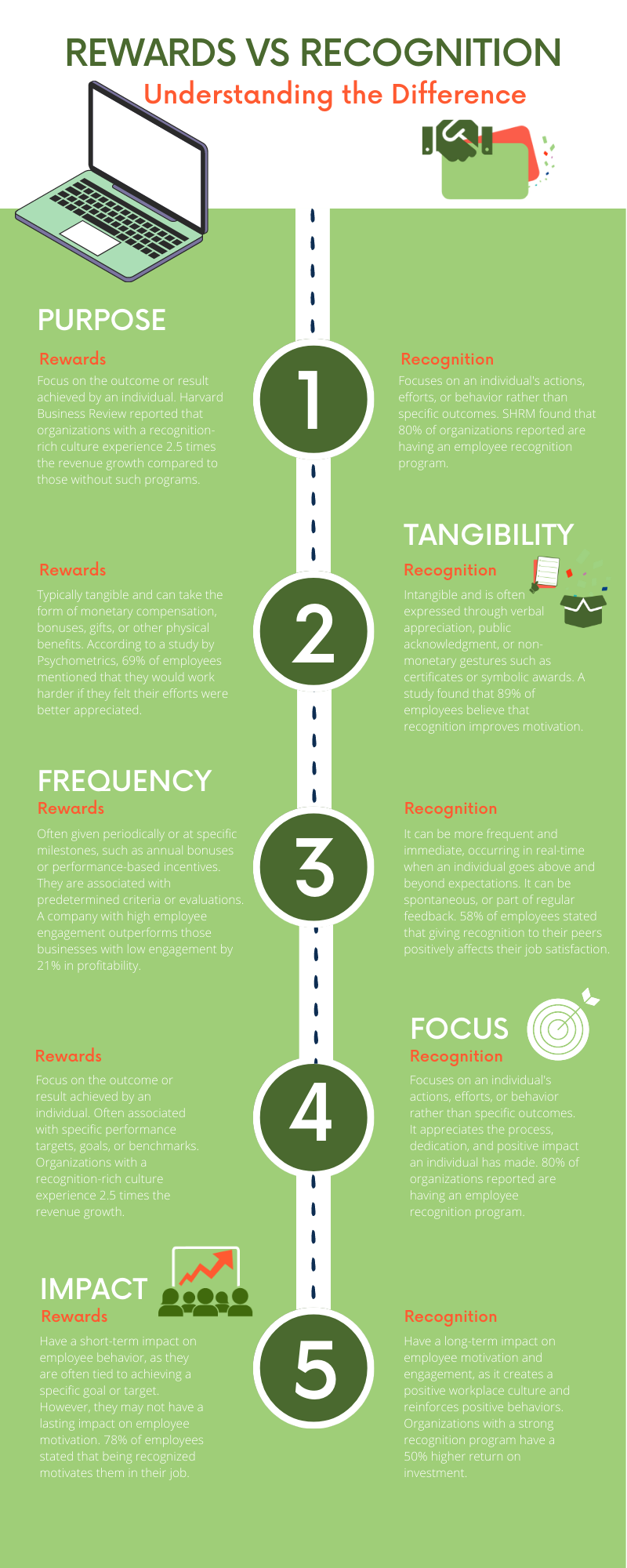Rewards And Recognition In The Workplace Infographic – 5 Big Distinctions

by Daniela Maria Zabrautanu
June 07, 2023
1. Introduction: Rewards and Recognition in the Workplace
Rewards and recognition are crucial components of a thriving workplace culture. They can motivate employees to perform better, increase job satisfaction, and decrease employee turnover rates. However, rewards and recognition are not interchangeable terms. They have distinct differences that can affect how they impact employee behavior. In this blog post, we, Huuray, will explore the five big distinctions between rewards and recognition in the workplace, and how understanding these differences can help companies create an effective system of incentives. So let’s dive in and discover the nuances of rewards and recognition!
Jump to
2. Rewards vs. Recognition: Understanding the Difference

Rewards and recognition are two terms that are often used interchangeably in the workplace. However, by definition, they have distinct differences that can greatly impact how they affect employee behavior and motivation. Here are the five big distinctions between rewards and recognition:
1. Purpose
- Rewards: The primary purpose of rewards is to provide tangible incentives to individuals based on their performance, achievements, or behavior. The purpose of rewards is to motivate employees to perform better by offering a tangible incentive for their efforts. According to a survey by O.C. Tanner, 37% of employees consider recognition as the most important action an employer can take to improve engagement.
- Recognition: On the other hand, recognition aims to acknowledge and appreciate an individual’s contributions, efforts, or accomplishments. The purpose of recognition is to appreciate employees for their hard work and to create a positive workplace culture. Research conducted by Bersin & Associates found that organizations with effective recognition programs experience 31% lower employee turnover rates.
2. Tangibility
- Rewards: Rewards are typically tangible and can take the form of monetary compensation, bonuses, gifts, or other physical benefits. According to a study by Psychometrics, 69% of employees mentioned that they would work harder if they felt their efforts were better appreciated.
- Recognition: In contrast, recognition is intangible and is often expressed through verbal appreciation, public acknowledgment, or non-monetary gestures such as certificates or symbolic awards. The Workhuman Analytics & Research Institute found that 89% of employees believe that recognition, when tied to performance, improves motivation.
3. Frequency
- Rewards: Rewards are often given periodically or at specific milestones, such as annual bonuses or performance-based incentives. They are associated with predetermined criteria or evaluations. According to Gallup, a company with high employee engagement outperform those businesses with low engagement by 23% in profitability.
- Recognition: Recognition can be more frequent and immediate, occurring in real-time when an individual demonstrates exceptional work or goes above and beyond expectations. It can be spontaneous, ongoing, or part of regular feedback and appreciation efforts. A survey by the Cicero Group found that 58% of employees stated that giving recognition to their peers positively affects their job satisfaction.
4. Focus
- Rewards: Rewards typically focus on the outcome or result achieved by an individual. They are often associated with specific performance targets, goals, or benchmarks. Harvard Business Review reported that organizations with a recognition-rich culture experience 2.5 times the revenue growth compared to those without such programs.
- Recognition: In contrast, recognition focuses on an individual’s actions, efforts, or behavior rather than specific outcomes. It appreciates the process, dedication, and positive impact an individual has made. The Society for Human Resource Management (SHRM) found that 80% of organizations reported are having an employee recognition program.
5. Impact
- Rewards: Rewards can have a short-term impact on employee behavior, as they are often tied to achieving a specific goal or target. However, they may not have a lasting impact on employee motivation. The Globoforce survey revealed that 78% of employees stated that being recognized motivates them in their job.
- Recognition: Recognition, on the other hand, can have a long-term impact on employee motivation and engagement, as it creates a positive workplace culture and reinforces positive behaviors. According to SHRM, organizations with a strong recognition program have a 50% higher return on investment.
Understanding the differences between rewards and recognition is crucial to create an effective system of employee incentives in the workplace. By offering both rewards and recognition, companies can motivate employees to achieve specific goals while also creating a positive workplace culture that values employee contributions.

3. The Importance of Rewards and Recognition in Motivating Employees
In the quest to unlock the full potential of employees, organizations are constantly seeking effective methods to motivate and engage their workforce. Among the powerful tools in their arsenal are rewards and recognition. These two pillars play a pivotal role in fostering a positive work environment, boosting morale, and driving productivity.
Rewards: Fueling the Fire of Achievement
Rewards are tangible incentives that ignite motivation and propel employees toward excellence. They create a sense of value and appreciation for their hard work. Studies have shown that 78% of employees find recognition to be a powerful motivator in their jobs. By offering rewards, such as bonuses, gifts, or other material benefits, organizations can:
- Drive Performance: Rewards tied to performance targets or goals inspire employees to put forth their best effort. The promise of recognition drives them to surpass their own expectations and strive for excellence.
- Foster Healthy Competition: Reward programs can spark friendly competition, encouraging employees to go above and beyond in their endeavors. This healthy rivalry fuels a vibrant work atmosphere and drives innovation.
- Reinforce Desired Behaviors: When rewards are linked to specific behaviors or achievements, they act as a powerful reinforcement tool. Employees are motivated to exhibit the desired behaviors consistently, resulting in increased productivity and success.
Recognition: Nurturing the Seeds of Appreciation
Recognition is the fuel that nourishes the human spirit within the workplace. It acknowledges and appreciates the contributions and efforts of employees, creating a culture of gratitude and camaraderie. In a SHRM/Globoforce survey, 68% of HR professionals agreed that employee recognition has a positive impact on retention and 56% said these programs help with recruitment. By incorporating recognition into the fabric of an organization, it can:
- Cultivate a Sense of Belonging: Recognition fosters a sense of belonging and affirmation, making employees feel valued and appreciated. It strengthens their emotional connection to the organization, promoting loyalty and dedication.
- Boost Engagement and Morale: A culture of recognition fuels employee engagement by making them feel that their work matters. When employees are recognized for their efforts, their morale soars, leading to increased job satisfaction and commitment.
- Inspire Continuous Improvement: Recognition is a catalyst for growth and personal development. By acknowledging achievements, organizations inspire employees to continually improve their skills and exceed expectations.

4. Creating an Effective Rewards and Recognition Program
Let’s explore the ultimate elements and best practices for building an effective rewards and recognition program that drives employee satisfaction, loyalty, and top performance. If you’d like to make one in-house, follow our guide to making a reward system for employees.
Key Components of an Effective Rewards and Recognition Program:
- Clearly Defined Objectives: Start by establishing the goals of your program, such as improving employee morale, increasing productivity, or enhancing employee retention. Clearly defined objectives provide meaning and a roadmap for designing and evaluating the program’s effectiveness.
- Types of Rewards and Recognition: Incorporate a variety of rewards and recognition to cater to different preferences and achievements. This can include monetary rewards, such as bonuses or gift cards, as well as non-monetary recognition, such as public praise, certificates, or career development opportunities.
- Fair and Transparent Criteria: Ensure that the selection criteria for rewards and recognition are fair, transparent, and aligned with the organization’s values and goals to establish trust. Recognize both individual accomplishments and collaborative team efforts to promote a sense of unity and cooperation.
- Timeliness and Frequency: Implement a program that offers timely and frequent recognition to maximize its impact. Real-time acknowledgment and immediate rewards create a positive feedback loop, reinforcing wanted behaviors and boosting morale.
- Communication and Promotion: Effectively communicate the program’s purpose, benefits, and guidelines to all employees. Regularly promote the program through multiple channels, such as newsletters, meetings, and intranet platforms, to increase participation and awareness.
Related: Employee Incentive Programs: The Ultimate Guide to Retaining Top Talent in 2023
Best Practices for Implementation:
- Leadership Buy-In and Involvement: Ensure that organizational leaders actively support and participate in the rewards and recognition program. Their involvement sends a powerful message of endorsement and encourages employee engagement.
- Peer-to-Peer Recognition: Encourage a culture of peer-to-peer recognition, where employees can appreciate and celebrate each other’s achievements. This creates a supportive and collaborative atmosphere, strengthening team bonds.
- Continuous Evaluation and Improvement: Regularly assess the program’s effectiveness through employee feedback, surveys, and performance metrics. Use these insights to make adjustments and improvements, ensuring the program remains relevant and impactful.
- Flexibility and Personalization: Allow flexibility for employees to choose their preferred rewards or recognition options, whenever possible. Personalization enhances the program’s effectiveness and makes employees feel valued as individuals.
Read also: Incentive Pay Vs Merit Pay: Different Ways To Reward Employees
5. Examples of Successful Rewards and Recognition Programs
To inspire your own initiatives, we’ve curated a collection of successful recognition and rewards program ideas from organizations that have elevated their workplace cultures. These examples showcase innovative approaches that can spark creativity and help you design a program that resonates with your employees. Don’t stop only at your workforce. Consumer incentives hold great power and can help you boost customer retention and loyalty.
a. Peer-to-Peer Shoutouts
Encourage employees to recognize and appreciate their colleagues’ contributions through a dedicated platform or regular team meetings. This fosters a culture of appreciation and builds stronger connections within the workforce. Consider implementing a “Shoutout Wall” where employees can publicly acknowledge their peers’ achievements and display a collective sense of recognition.
b. Flexible Rewards Menu
Create a menu of rewards tailored to individual preferences. Allow employees to choose from a range of options such as extra vacation days, professional development opportunities, personalized gifts, or the option to donate to a charity of their choice. This empowers employees to select rewards that truly resonate with their interests and aspirations.
c. Employee of the Month Programs
Recognize outstanding performance by highlighting an exceptional employee each month. Along with a personalized certificate or trophy, provide additional benefits like reserved parking, a special lunch with the CEO, or a small bonus. This program not only rewards individual excellence but also boosts overall morale and inspires healthy competition.
d. Team-based Incentives
Design rewards and recognition initiatives that celebrate collective accomplishments. For example, establish team targets and reward the entire team when goals are achieved. This approach fosters collaboration, encourages mutual support, and strengthens team cohesion. Ideas for team rewards could include team outings, team-building activities, or sponsored lunches.
e. Innovation and Ideas Recognition
Create a platform or suggestion box where employees can submit innovative ideas or process improvements. Recognize and reward employees whose ideas are implemented or contribute significantly to the organization’s success. This cultivates a culture of innovation, empowers employees to contribute their unique insights, and enhances overall creativity within the company.
f. Service Milestones and Longevity Awards
Acknowledge employees’ loyalty and dedication by celebrating service milestones. Consider presenting personalized gifts, plaques, or unique experiences to commemorate significant years of service. Such recognition programs showcase the organization’s appreciation for long-term commitment and create a sense of belonging and loyalty.
g. Wellness and Work-Life Balance Rewards
Support employees’ well-being by offering rewards related to health and work-life balance. This could include gym memberships, wellness programs, flexible work arrangements, or additional paid time off. Prioritizing employees’ physical and mental well-being demonstrates a commitment to their holistic success.
h. Social Recognition Wall
Establish a digital platform or physical wall where employees can publicly recognize and appreciate their colleagues’ accomplishments. This provides a visible and ongoing source of motivation and fosters a culture of gratitude. Encourage employees to share stories, achievements, and instances of exceptional teamwork to reinforce positive behaviors.
Related: Read our guide to Employee Anniversary Gifts and Tips for Gift Giving
6. Conclusion: The Power of Rewards and Recognition in the Workplace
In conclusion, implementing a comprehensive rewards and recognition strategy can significantly enhance employee motivation, engagement, and satisfaction. While rewards provide tangible incentives based on outcomes, recognition focuses on acknowledging efforts and positive behavior. By combining both elements, organizations can create a culture of appreciation and empowerment that cultivates innovation, loyalty, and overall well-being. Whether it’s through personalized gifts for service milestones, wellness programs, or a social recognition wall, the power of rewards and recognition in the workplace cannot be overstated. As a Human Resources professional, it’s essential to understand the differences between rewards and recognition and how to effectively implement them to incentivize and motivate employees. By doing so, you can create a positive work environment that fosters growth, success, and increased productivity.



Let’s have a chat
Frequently asked questions on Rewards and Recognition
The Employee of the Month program is one example of rewards and recognition. Other examples include spot bonuses, performance-based incentives, team-based rewards, service milestone acknowledgments, and peer-to-peer recognition programs. The specific rewards and recognition initiatives can vary based on the organization’s culture, budget, and goals. The key is to design a program that aligns with the values of the organization and effectively motivates and appreciates employees for their exceptional work.
Rewards and recognition motivate employees by instilling a sense of achievement, combining intrinsic and extrinsic motivation factors, orienting employees toward goals, increasing job satisfaction, providing positive reinforcement, fostering fairness, offering social validation, and supporting career development. By leveraging these motivational factors, organizations can create a work environment that inspires and engages employees to achieve their best.
Rewards and recognition are important in the workplace because they drive employee motivation, engagement, loyalty, and performance. They contribute to a positive work culture, promote teamwork, and enhance employee well-being. By implementing effective rewards and recognition programs, organizations can create an environment that fosters success, productivity, and the long-term growth of both individuals and the organization as a whole.